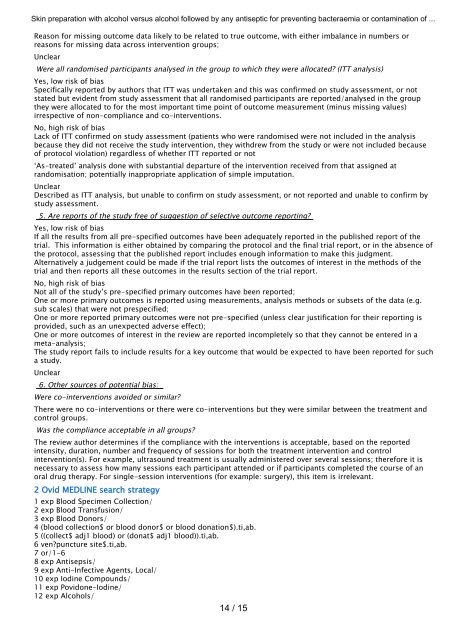Lignes directrices de l'OMS applicables aux prélèvements sanguins ...
Lignes directrices de l'OMS applicables aux prélèvements sanguins ...
Lignes directrices de l'OMS applicables aux prélèvements sanguins ...
Create successful ePaper yourself
Turn your PDF publications into a flip-book with our unique Google optimized e-Paper software.
Skin preparation with alcohol versus alcohol followed by any antiseptic for preventing bacteraemia or contamination of ...<br />
Reason for missing outcome data likely to be related to true outcome, with either imbalance in numbers or<br />
reasons for missing data across intervention groups;<br />
Unclear<br />
Were all randomised participants analysed in the group to which they were allocated? (ITT analysis)<br />
Yes, low risk of bias<br />
Specifically reported by authors that ITT was un<strong>de</strong>rtaken and this was confirmed on study assessment, or not<br />
stated but evi<strong>de</strong>nt from study assessment that all randomised participants are reported/analysed in the group<br />
they were allocated to for the most important time point of outcome measurement (minus missing values)<br />
irrespective of non-compliance and co-interventions.<br />
No, high risk of bias<br />
Lack of ITT confirmed on study assessment (patients who were randomised were not inclu<strong>de</strong>d in the analysis<br />
because they did not receive the study intervention, they withdrew from the study or were not inclu<strong>de</strong>d because<br />
of protocol violation) regardless of whether ITT reported or not<br />
‘As-treated’ analysis done with substantial <strong>de</strong>parture of the intervention received from that assigned at<br />
randomisation; potentially inappropriate application of simple imputation.<br />
Unclear<br />
Described as ITT analysis, but unable to confirm on study assessment, or not reported and unable to confirm by<br />
study assessment.<br />
5. Are reports of the study free of suggestion of selective outcome reporting?<br />
Yes, low risk of bias<br />
If all the results from all pre-specified outcomes have been a<strong>de</strong>quately reported in the published report of the<br />
trial. This information is either obtained by comparing the protocol and the final trial report, or in the absence of<br />
the protocol, assessing that the published report inclu<strong>de</strong>s enough information to make this judgment.<br />
Alternatively a judgement could be ma<strong>de</strong> if the trial report lists the outcomes of interest in the methods of the<br />
trial and then reports all these outcomes in the results section of the trial report.<br />
No, high risk of bias<br />
Not all of the study’s pre-specified primary outcomes have been reported;<br />
One or more primary outcomes is reported using measurements, analysis methods or subsets of the data (e.g.<br />
sub scales) that were not prespecified;<br />
One or more reported primary outcomes were not pre-specified (unless clear justification for their reporting is<br />
provi<strong>de</strong>d, such as an unexpected adverse effect);<br />
One or more outcomes of interest in the review are reported incompletely so that they cannot be entered in a<br />
meta-analysis;<br />
The study report fails to inclu<strong>de</strong> results for a key outcome that would be expected to have been reported for such<br />
a study.<br />
Unclear<br />
6. Other sources of potential bias:<br />
Were co-interventions avoi<strong>de</strong>d or similar?<br />
There were no co-interventions or there were co-interventions but they were similar between the treatment and<br />
control groups.<br />
Was the compliance acceptable in all groups?<br />
The review author <strong>de</strong>termines if the compliance with the interventions is acceptable, based on the reported<br />
intensity, duration, number and frequency of sessions for both the treatment intervention and control<br />
intervention(s). For example, ultrasound treatment is usually administered over several sessions; therefore it is<br />
necessary to assess how many sessions each participant atten<strong>de</strong>d or if participants completed the course of an<br />
oral drug therapy. For single-session interventions (for example: surgery), this item is irrelevant.<br />
2 Ovid MEDLINE search strategy<br />
1 exp Blood Specimen Collection/<br />
2 exp Blood Transfusion/<br />
3 exp Blood Donors/<br />
4 (blood collection$ or blood donor$ or blood donation$).ti,ab.<br />
5 ((collect$ adj1 blood) or (donat$ adj1 blood)).ti,ab.<br />
6 ven?puncture site$.ti,ab.<br />
7 or/1-6<br />
8 exp Antisepsis/<br />
9 exp Anti-Infective Agents, Local/<br />
10 exp Iodine Compounds/<br />
11 exp Povidone-Iodine/<br />
12 exp Alcohols/<br />
14 / 15

















